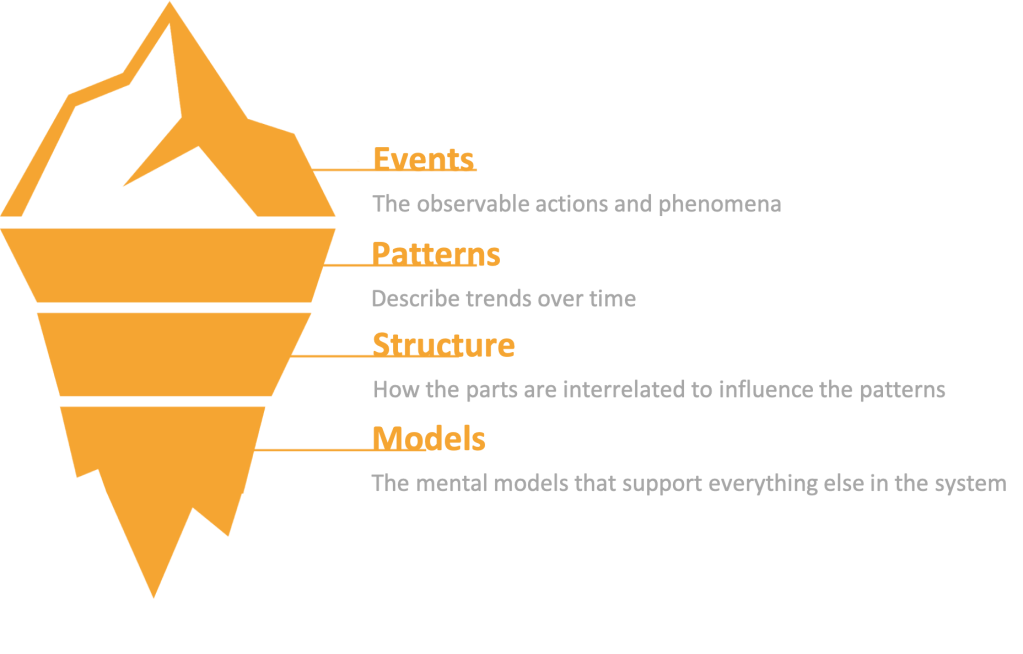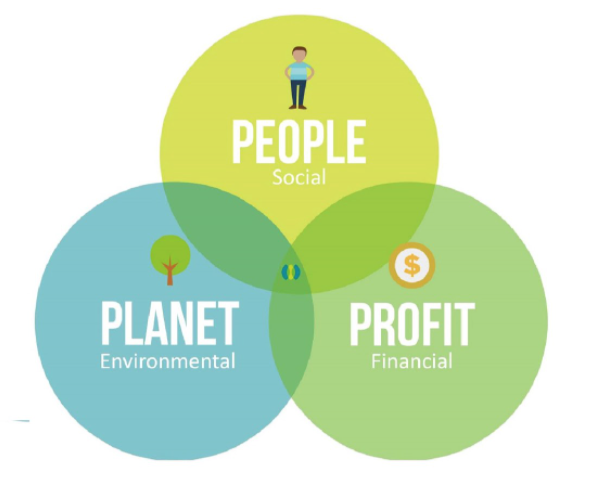Tipping points and systems-based approaches to causing a sustainability mindshift
We read about tipping points quite regularly in the news these days, especially as they relate to climate change and global-level systems breakdowns (e.g. biodiversity, oceans, forests, refugees, pandemic-related supply chains, etc). The phrase “tipping point” is nothing new, but it exploded out of the language of scientists to become a colloquial term after Malcolm Gladwell published his book, The Tipping Point: How Little Things Can Make a Big Difference. Not long after that, Al Gore published his book, An inconvenient Truth, which captured the world’s attention to the growing reality of human-accelerated climate change.
As I sat down with my coffee this morning, I read a headline from The Guardian in my news feed that I would normally wince at, shake my head, and move on. Something about this one made me click…
“Climate tipping points could topple like dominoes, warn scientists”

It is ironic that, as a sustainability practitioner, I’ve been shouting from atop my soap box for over 25 years; hoping to convince corporate leaders to take sustainability seriously – as a core part of their business strategy rather than a “nice to have” set of initiatives. Twenty, fifteen, even ten years ago, I used to devour any and all news related to climate change. About five or six years ago, climate change and sustainability started making the news more regularly. I saw this as a global awakening of sorts and was happy to know that we humans were starting to hold ourselves accountable for accelerating climate change. However, today, with the onslaught of news about climate change, I can’t help but think of my children’s future every time I see a headline like this and often pass it up. This existential nightmare we have created is just too much to bear sometimes.
Sadness and pessimism aside, I chose to read this article and it is interesting to me because it explores what is happening to our world and climate change from a systems perspective. The article points to new research that examined the interactions between ice sheets in West Antarctica, Greenland, the Atlantic Gulf Stream and the Amazon rainforest.
“An example of the complex chain of interactions the researchers tracked is the melting of the Greenland ice sheet. This releases fresh water into the ocean and slows down the Atlantic Meridional Overturning Circulation (AMOC), which is driven partly by dense, salty water being pulled down towards the ocean floor. A weaker AMOC means less heat is transported from the tropics towards the north pole, which in turn leads to warmer waters in the Southern Ocean. This can then destabilize ice sheets in Antarctica, which pushes up global sea level and causes more melting at the edges of the Greenland ice sheet.“
Fascinating and scary stuff! I have always been fascinated by systems, whether I knew it or not, from an early age. As I boy I used to sit for hours outside and simply watch and listen to the natural and human world moving around me.

I observed ants working relentlessly all day to build their mounds, only to be washed away by the rain, and dragonflies dipping their tails into the lake; watching the tiny ripples emanate outward until they interfered with other ripples. My interest in systems grew as I worked in the rainforests of Costa Rica and Guatemala. I was fascinated by the interdependent relationship that subsistence communities had with the forests around them. Their livelihoods and economy, as well as their culture, health and wellbeing were intimately tied to the forest ecosystems…and yet, due to the economic and political systems within which they lived, they aggressively cut down the rainforests to plant corn and beans out of necessity. The economic gain was minimal and the negative impacts on everything else were high. This was a clear example of several systems that were out of alignment, and people / human lives were caught in the middle. These experiences developed my understanding of systems and the relationships between systems.
Years later, I am now working to help cause systems change and sustainability transformation through work I am doing with Transitioning To Green and through my Sustainability Mindshift Podcast and Blog. There is a wealth of knowledge and wisdom out there that we need to start incorporating more formally into our Human Capital Management systems as well as our personal and professional development. It will take a interdisciplinary approach, a convergence of many areas of expertise and thought leadership; including systems thinking and innovation, organizational development, leadership development, experiential learning, adult learning, mindfulness, behavioral psychology and positive psychology, to name a few.
To change systems, we must start with our own deeper understanding and relationship with the systems within which we live and work. We often exist and operate in a reactionary state; reacting to the events we see around us. To be effective, we must develop the capability to dig deeper and look at the underlying patterns, structures, and mental models that support these systems.

The Iceberg Model is a model used in systems thinking to illustrate the number of levels that are actually “hidden” from view. (below the water line). The lower on the iceberg we go, the more leverage we have for systems change and, in this case, sustainability transformation. We often respond symptomatically to events. It’s how we deal with daily challenges, especially during times of change and, even more so, how we respond to events that are unforeseen or out of our ordinary context. I have been guilty of applying this reactionary response to the headlines I see in the news about climate change. Sometimes it is unbearable… I mean, facing an existential threat is something that is psychologically very difficult for most of us to bear. So we shrug, maybe wince, and then shift our thoughts to the day’s tasks at hand or to something more positive.
For us to successfully avoid catastrophe (the collapse of planetary systems and, ultimately, civilization), we need to squarely and courageously face our current reality. And not only that, we need to use the Iceberg Model and a systems-based approach to thinking and questioning so that we can better understand. There are benefits to this approach beyond systems knowledge and wisdom. Deeper levels of questioning often leads to self discovery and new systemic insights that reveal hidden risks and value-creating opportunities which, if avoided or executed, could alter the course of your business’ sustainability transformation. Practice this with yourself or, better yet, invite other key stakeholders into a discussion where you give everyone a chance to share their perspectives.
Patterns: Start by observing the system and looking for patterns. These are the changes and trends that occur over a period of time which indicate that an event is not an isolated incident. This practice forces us to consider a long-term view of events and look for reoccurrence or alterations in those patterns. When we get to this level of thinking, we can anticipate, plan, and forecast; allowing us to adapt. Many business leaders are adept at thinking in terms of patterns. They do this regularly when they evaluate their business and forecast for future growth, risk, and profitability. However, most leaders spend much of their time evaluating their business within the context of their financial systems and economic models and mindsets. It is important for leaders to think more about their business within the context of a highly interconnected and interdependent network of systems; including social and planetary systems. Leaders don’t need to be systems or sustainability experts, but it is important to take the time to pause before making big decisions and ask themselves:
- Who are stakeholders I may not be considering in this decision (especially concerning people and planet)?
- What potentially could be both positive and negative, short and long term impacts of this decision on these stakeholders?
- Who is benefiting and who is being harmed by this decision?
- With whom can I talk to help inform this decision?
This way of thinking has often been referred to as Triple Bottom Line where sustainability sits at the intersection of these three systems: People (social dimension), Planet (environmental dimension), and Profit (economic dimension):

The reality is that these systems are not as “neat” as this graphic displays. These systems are more accurately represented by this next graphic which shows “nested” systems – systems that exist within other systems. Almost everything in the Universe is made up of nested systems. Each system is an integrated whole and, at the same time, part of larger systems. Changes within one of these systems can affect the sustainability of all the systems that are within it, and within which it exists.

Structure: Examining the structure underlying the patterns is an important next step. The structure creates, supports and influences the observable patterns we see in events. Structure is the result of causes and effects from interactions and relationships of any given system. It is what forms the connections between patterns. Think of structure as the institutionalized norms, policies, and procedures. This is where, all too too often, leaders fall short because they don’t intentionally set time aside (or are not able to given their business culture or due to other pressures) to evaluate and question the business structures that are in place. This requires deeper levels of strategic thinking and reflection, and ideally input from diverse perspectives, within the context of sustainable systems that are much bigger and broader than their business system (or understanding that their business system is really made up of elements and stakeholders not traditionally accounted for: society and planet, for example.
Models: These are the mental models that drive our world views, our attitudes and assumptions, and our morals and values. These mental models influence / control the way we think and, as a result, the way we behave which ultimately shapes our culture. This is where Sustainability Mindshift lives. As you can see, mental models are are deeply “buried” beneath the events we see today. Sure, nature has its own structures and patterns that are influencing climate change. Thanks to science, we now better understand that climate change is a natural phenomenon that has occurred since the early beginnings of this planet’s climate. But we also know that human decisions and behaviors, and most powerfully in the form of political and economic / business decisions, are being influenced by mental models that have prioritized things that are out of touch with our planetary systems e.g. short term financial gains over long term social and environmental wellbeing; focused wealth in the hands of a few at the expense of many who are now struggling to survive; human, social and environmental capital that have been turned into externalities and figures on a balance sheet to be manipulated in the name of managing risk, growth, and profit. These same mental models are what have contributed to our (soon-to-be) runaway climate change that is threatening our very survival.

But, rather than pointing fingers and calling blame, right now, we have an unprecedented opportunity to leverage a growing field and network of practitioners, thought leaders, and experts who are working passionately on this very issue – to cause a shift in the way we understand the world and how we behave in accordance with our personal and business transformation toward a sustainable and thriving future. I look forward to exploring these expert perspectives, stories and solutions with you. Welcome to Sustainability Mindshift!
